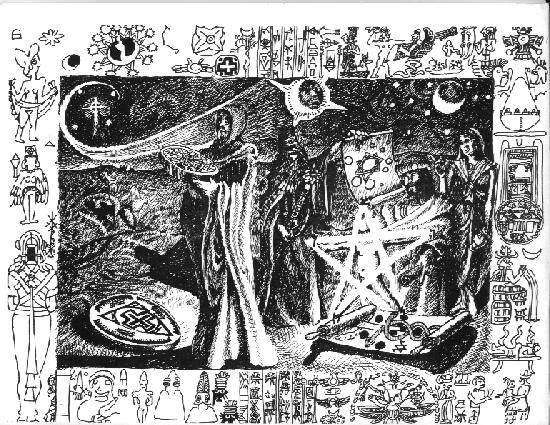

This years Christmas card was primarily inspired by the implications of theories expressed by professor Zecharia Sitchin in his books concerning a tenth planet in our solar system with a 3600 year orbit that brings it at its nearest point between Mars and Jupiter. It was also inspired by interpretations of ancient Sumerian writings where he derived his conclusion. This Christmas card also hails the year (1991) when modern day astronomers finally acknowledge a tenth planet in our system which they have had evidence of for years. The theme of the card is the Magi from the east who recognized a new star in the sky and traveled to Israel to behold the promised messiah that the star heralded. The card assumes that the Magi were from Mesopotamia in the east where the kingdom of Samaria had its day in history as the first known civilization beginning approximately 3600 BC. It should be pointed out at this point that the patriarch, Abraham, was born and raised in Samaria in the city of Ur. It is also an anthropological fact that the early portions of the book of Genesis are actually summarized versions of more ancient Sumerian myths that Abraham probably took with him after his theological disagreement with the local faith. Because of their strict adherence to genealogy and the fact that they were forbidden to breed with other races, Israel at the time actually represented the purest most direct genetic strain of Sumerian blood in existence. Because of these facts, the Magi knew where the promised messiah would be born. The scene in the sky shows the spirit of the four moons of the star intimidating Earth's moon along with the spirits of ten deceased comrade moons. This eludes to a Sumerian account of an ancient battle between planets in the infancy of the solar system which robbed Earth's moon of the destiny of existing in a planetary orbit of its own. The battle also destroyed the ten other moons of Earth and gashed a wound on Earth around the present day Pacific ocean which hurled the planet into her present orbit of today. The asteroid belt remains as a testament to this primordial catastrophe to this day. As for Earth, the wound swallowed most of the planet's water which exposed the land on the other side. This half of the planet dried into tectonic plates that are still moving like clotted cells to heal the wound. The meaning of the scene on the card, however, eludes to the unconscious psychological impact of the star on the people of Earth, particularly around Asia. The people of Asia at the time were experiencing a prolific literary revival of Gnosis (knowledge). This wave of Gnosticism produced countless scriptures of all kinds that have only until recently been blotted out of history by a cover-up instigated in Nicea (approximately 325AD). This revival of creative writing across Asia is much like the shelves of fictional literature being produced in this enlightened age. Below the scene in the sky are the Magi. The first Magi on the left represents the faith of the Magi. He is using ancient Sumerian tablets with cuneiform writing to delineate their position in relation to the star. He is guided on his insatiable quest for data by an inner gnosis made up of his own collection of accumulated data. His inner gnosis is the substance of what is hoped for and his evidence of what is not seen. He is a scientist who observes and records data for further analysis. He does this undistracted by the divine child who shines brilliantly behind him. The next Magi embodies their hopes of utilizing their magical knowledge to gain greater understanding of the things not seen. He holds in his right hand a lotus wand which he uses as a focal point for directing his divine will. He is a philosopher who beholds the divine child and finds his vast vocabulary of accumulated knowledge inflamed with the inspiration to instruct. Therefore in his left hand he holds a Sumerian drawing showing the solar system as they understood it. This is used to teach Mary about the star that brought them to the child. The last Magi who is closest to the divine child demonstrates the Love of the Magi. He is the Magi who has been driven through all his magical training by a sincere devotion and unquenchable desire to see G-d. His true love for the Great Work has lead him across countries and deserts to this scene with the divine child. Here he lays a parchment with the Caduceus of Hermes on it at the feet of the divine child of the star. The Caduceus of Hermes represents the word of G-d which becomes flesh and dwells among men. This brings us to the Sumerian hieroglyphics which border the card. These are pictures and stories that such knowledgeable men probably studied in the course of their initiation in the magical arts that have their roots in the ancient writings of Samaria. They begin on the bottom middle which is an example of cuneiform writing. This is the form of writing which evolved out of the hieroglyphic writing of ancient Samaria. After this reading to the right are some winged globes which may be older depiction's of the star. After the globes is a picture of the Egyptian god Horus. Horus was the child of Isis and is often depicted cradled in the arms of Isis who is standing on the moon and crowned with stars. Such depiction's have haunting similarities to modern day statues of Mary with child. Following this is the Sumerian god Enki who, according to Sumerian myth, created the first man in southeast Africa. This is followed by a hieroglyphic scene of Enki and his consort creating the first man who the Sumerians called Adama. Going up the right side is a man on a hospital bed, then another picture of Enki followed by a Sumerian coin with a temple on it. Above the coin is another depiction of a temple. These drawings, which were copied from genuine Sumerian hieroglyphs, are intended to imply spacecraft. This leads to the upper right corner where the gods Enki and his rival god Enlil, who was the leader of the gods on Earth, are shown as birds hailing a craft in the sky. From this corner we go on to another picture of Enki who was based in southeast Africa (the underworld). Then there is another picture of a craft being observed from a boat. Now we arrive at a picture of Enki who is shown as a serpent battling with Enlil who, according to legend, went down from his base in Mesopotamia and fought Enki to obtain some of the humans that Enki had made. The Sumerians taught that man was created by the gods to serve in their mining operations as slaves. The bible also states that man was created to work in the garden. The appearance of the star in the sky triggered a recollection of the slave experience on the level of the collective unconscious in Asia which was the source of Gnostic inspiration. This is the fear of G-d which is the beginning of wisdom. Following the battle scene is another picture of Enlil who was the god who established the first civilization on Earth in Mesopotamia called Samaria. Then comes more cuneiform writing. After this is more star symbols and a picture of a god surrounded by twelve stars. This symbol represents Sumerian astrology were modern day astrology is derived. In Sumerian astrology there are twelve planets since they counted the Sun and Moon as planets along with Earth and the newly discovered planet (ten planets plus the Sun and Moon). The twelve signs of the zodiac come directly from this system and modern astrology will look much more like the Sumerian system now that we have located the 12th planet the Sumerians already knew about. Going down the left side, garnished with more cuneiform letters are three depiction's of the Sumerian goddess Innana who is closely associated with magic. Curiously enough, Innana was often depicted holding her skirt up or in the suit she wore for flying. Perhaps one of the Magi told the divine child a bedtime story from Sumerian myth about the goddess Innana putting on her flying suit and descending into the underworld where she was killed and left to hang upon a spear for three days. After the three days passed she rose again from the dead and returned to her place among the gods. The remaining images are Sumerian god figures and hieroglyphics intended to imply extra terrestrial life which may have intervened in the affairs of man back when all of mankind were basically young impressionable children.
 Check out other graphic novels at Fantazine HOME
Check out other graphic novels at Fantazine HOME